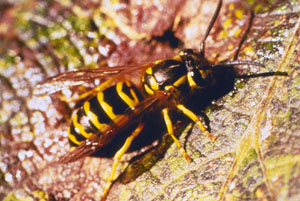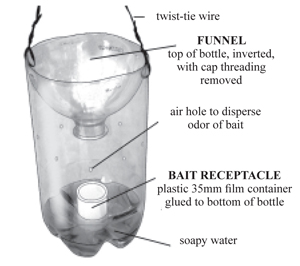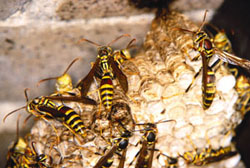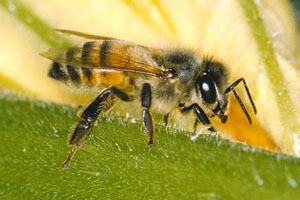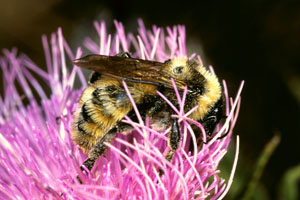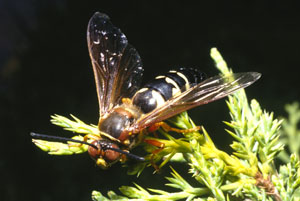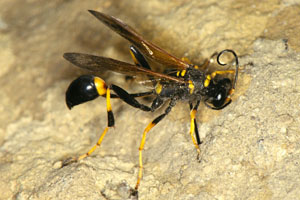G1447
Stinging Wasps and Bees
This NebGuide contains information on identifying and managing stinging wasps and bees as well as the symptoms and treatment of stings.
Frederick P. Baxendale, Extension Entomologist
Shripat T. Kamble, Extension Urban Entomologist
Marion D. Ellis, Extension Entomologist
- Symptoms and Treatment of Stings
- General Management Strategies
- Biology and Control of Specific Stinging Wasp and Bee Species
- Social Species
- Solitary Species
Sooner or later, many of us will have the unpleasant experience of being stung by a bee or wasp. Most insect stings occur during late summer and fall when stinging insects are most abundant. Generally, these insects will not sting unless stepped on, touched, or annoyed. Most stinging wasps and bees are beneficial and should be preserved unless they pose a direct hazard to humans. Some, including the honey bee, are important pollinators essential for the propagation of plants, including many agriculturally important crops. Honey bees also produce honey and beeswax. Most wasps and hornets are efficient predators and help regulate destructive insect populations that might otherwise adversely affect our health, homes, livestock, or crops.
Despite their many benefits, stinging insects may sometimes pose a hazard and it may become necessary to control them. Insect stings probably injure more people each year than all other venomous animals combined. Fortunately, recovery from most stings is rapid and occurs within several days. Only the females are capable of stinging because the stinger is actually a modified ovipositor or egg-laying tube. Originally, the stinger served to deposit eggs in protected areas or into the bodies of insect prey. Later, venom glands evolved and the stinger began to be used as a weapon to paralyze prey and defend the nest.
Symptoms and Treatment of Stings
Insect stings are normally characterized by moderate to severe pain, localized reddening and swelling, and occasionally even mild headache and fever. Treatment involves disinfecting the wounded area with soap and water. Meat tenderizer, which contains an enzyme that breaks down the venom, and/or a baking soda paste also may be applied to the sting site to help relieve pain. Several over-the-counter remedies also are available.
In allergic individuals, insect stings can cause a life-threatening systemic reaction that can rapidly lead to anaphylactic shock. Symptoms in these individuals usually appear within minutes after the sting. Localized swelling can be extensive with a hives-like condition occurring over the body. There also may be a choking sensation accompanied by difficult breathing and blueness in the lips and extremities. This may be followed by nausea, vomiting, and loss of consciousness. A physician should be consulted immediately if any of these symptoms appear after an insect sting.
Since there is no way to completely avoid stinging insects, individuals allergic to stings should consider a desensitization program and carry emergency medication.
General Management Strategies
In general, successful management of stinging insects involves one or more of the following strategies:
Avoid Attracting Wasps and Bees
Many wasp and bee species are scavengers and will forage for a wide variety of foods, including fruit, ice cream, soda pop, jelly, sweet salads, and meat products. In areas where these insects are active, do not leave foods in open containers. Placing food scraps in sealed trash receptacles also will help discourage scavenging activities. Home orchardists are encouraged to remove fallen fruit because these are highly attractive to many stinging insect species. Avoid wearing brightly colored clothing or highly scented cosmetic products where wasps and bees are abundant.
|
|||||||||||||||||||||||||||||||||||||||||||||||||||||||||||||||||||||||||||||||||||||||||||||||||||||||||||||||||||||||||||||||||||||||||||||||||||||||||
Locate Nesting Sites
When stinging insects are observed around buildings, lawns, shrubs, or gardens, do not panic; it is likely that they are simply searching for food. It also may be possible, however, that one or more nests are in the vicinity. If insect activities are persistent, try to locate nests during the day. An understanding of the nesting behavior of the species involved (described later in the biology section) will be helpful in this process. Mark the location and wait for nightfall.
Time Control Measures
The best time to control stinging insects is after dark when foraging adults have returned to their nests. Late evening or early morning treatments are preferred since these insects are generally less active at cooler temperatures. It is generally not advisable to attempt control of stinging insects during the daytime because adults are active and may attack in defense of the nest.
Use Protective Equipment
When preparing to treat for stinging insects, always wear a long-sleeved shirt, long pants tied at the ankles, socks and shoes. A hat covered with netting to protect the face and gloves to protect the hands and wrists also are recommended. If a flashlight is used, cover the lens with red cellophane wrap. Insects do not see well in red light and will not be attracted to your light.
Handle Insect Intruders in Homes and Automobiles
Occasionally, wasps and bees enter homes through open doors and windows. These insects are looking for a way out and often will settle by windows or glass doors. While resting, they can be easily eliminated with a fly swatter. Do not panic if a wasp or bee enters your automobile while you are driving. The best approach is to stay calm and leave the insect alone! Never attempt to kill the intruder while the automobile is moving. When it is safe, stop the automobile and remove your uninvited guest.
In some situations a 5 percent solution of a liquid dishwashing detergent in water can be used to kill unwanted stinging insects. When insects are coated with soapy water, it flows into their tracheal system and suffocates them. To be effective, the insects must be thoroughly wetted. Soapy water is especially useful for killing stinging insects that get into homes and vehicles. However, it is ineffective when applied to a nest or cavity occupied by stinging insects, and its use should be limited to well-exposed insects that can be thoroughly wetted.
Chemical Control
If needed, you should be able to apply an insecticide for the control of most stinging insects by yourself, but individuals who are allergic or fear these insects or their stings should probably consider hiring a professional pest control operator. When appropriate, select one of the insecticide products listed in Table I. These products are available under various brand names for control of stinging wasps and bees.
Biology and Control of Specific Stinging Wasp and Bee Species
Wasps and bees can be classified as solitary or social, depending on whether they live alone or in colonies. Solitary species such as cicada killers, carpenter bees, digger wasps, and mud daubers use their stingers to subdue the insects and spiders upon which they prey. These insects are normally quite docile and rarely attack people. Social bees and wasps such as yellowjackets, paper wasps, and honey bees use their stingers and venom as defensive weapons. When forced to defend themselves or their nests, they often will attack the intruder in large numbers.
Social Species
|
Yellowjackets
Yellowjackets feed on insects, spiders, and a variety of food items. They are medium-sized, stout-bodied, and black with bright yellow bands. Yellowjackets construct globular paper nests, usually in underground cavities. Favorite nesting sites include rodent burrows, compost piles, wood piles, and wall voids. Occasionally, these wasps will build aerial nests in garages, crawl spaces, or other enclosed areas. Nests are built of paper made by stripping wood fibers from trees, fences, garden stakes, and other wooden structures. The combs are built in tiers and surrounded by an outer paper covering.
When yellowjackets are disturbed, give them plenty of room since they are capable of inflicting painful, multiple stings. If yellowjackets become excited and appear about to attack, do not panic. Do not make any sudden movements and retreat slowly and calmly from the area.
Yellowjackets are scavengers and are frequently found foraging in compost piles and garbage receptacles. Their activity can be discouraged in the vicinity of patios, parks, picnic, and other recreational areas by covering all food and disposing wastes in covered containers. Turning compost piles regularly and placing insecticide-impregnated resin strips in the lids of garbage cans and dumpsters will help reduce the numbers of yellowjackets in these areas. Yellowjackets are highly attracted to overripe fruit. Prompt removal of fallen fruit should help reduce the attractiveness.
One strategy homeowners can use to reduce the number of yellowjackets in an area is to use baited yellowjacket traps (see Figure 2). Baits can be made from canned meats, tuna, or pet food, or can be purchased from most stores that carry insecticides. Traps should be hung in sunny locations around the periphery of the area to be protected.
Control strategies for yellowjacket colonies depend on nest locations
a) Aerial nests: From a safe distance and after dark, treat the nest with liquid or aerosol jet spray insecticide (Table I). Remove the nest a day or two later.
b) Ground nests: Treat the nest with dust or liquid insecticide formulations (Table I) after dark. Approach the nest very carefully, since a number of yellowjackets will typically be guarding its entrance. Apply the insecticide, then quickly seal the nest opening with a shovelful of dirt, a sheet of plywood, or a flat rock. Insecticide dust formulations are generally preferred because workers attempting to use the nest opening will track dust and contaminate brood and other colony members. Retreatment may be necessary after a few days if yellowjacket activity continues.
c) Nests within cavities: Yellowjackets occasionally build their nests in wall voids, cracks in stone walls, or other cavities associated with buildings. In such cases, do not seal the entrance hole following the insecticide treatment because yellowjackets attempting to leave the nest may enter the building through inside openings. Insecticide dust formulations (Table I) are preferred since the workers entering or leaving the nest will tend to be contaminated.
|
Paper or Umbrella Wasps
Paper wasps are about 1 inch long, have a spindle-shaped body, and are marked with a brown and yellow pattern. Paper wasps construct umbrella-shaped, single-layered nests with exposed cells. Nests may be built in trees and shrubs but are frequently found under building overhangs, or in attics, barns, garages, and sheds.
Nests are initiated in the spring by a single overwintered queen called the foundress. Other fertile females often join the colony later in the season. Colonies may produce up to 200 individuals by summer’s end. These wasps are not considered overly aggressive and usually only pose a threat when their nests are disturbed. However, foraging wasps can cause considerable annoyance as they fly in and about building entrances. The best approach for controlling paper wasps is to treat nests with liquid or aerosol jet insecticide sprays after dark. Knocking down a nest without an insecticide treatment is usually ineffective since these wasps will rebuild the nest in a short time.
Honey Bees
Honey bees may become troublesome when they swarm or build colonies in or near residential areas. Honey bees occasionally invade homes and establish a colony, building combs of wax containing honey, pollen, and brood in wall spaces. Once established, a colony is difficult to remove because it usually involves structural modification of the building. To be effective, the honey and wax should be removed along with the bees or the site will remain attractive to other swarms. In addition, ants, carpet beetles, flies, and cockroaches may find their way to the comb to feed and reproduce.
Several methods may be used to control honey bees once they are established in a building, but prevention is the best way to avoid the problem. Good maintenance, including painting, repairing or replacing rotted boards or broken brick, and caulking, can prevent a colony from getting started. If a colony becomes established, call a local beekeeper who may be interested in removing the colony. Names of beekeepers can be obtained through your local Extension office or the Bureau of Plant Industry in the Nebraska Department of Agriculture in Lincoln.
If the bees must be destroyed, apply an insecticide dust or spray (Table I) in the evening when bees have returned to the colony and temperatures are cooler. Pyrethrins are particularly effective because they provide rapid knockdown. In many cases, it is difficult to directly contact combs with the insecticide since they are often some distance from the building’s point of entry. It is probably best to hire an experienced beekeeper or pest control operator to do the job.
CAUTION: You should never use honey or wax from honey bee colonies that have been treated with an insecticide. Also, never attempt to kill bees in buildings with liquid petroleum, gasoline, or any other flammable material. The entire structure may be destroyed along with the bees.
|
Bumble Bees
These bees most commonly become a problem when they establish nests close to a sidewalk or near a building foundation. Bumble bees are large, robust bees covered with dense black and yellow hairs. They commonly reach 1 inch in length. Bumble bees usually are not overly aggressive, but they will sting if molested. Avoid flower patches where adult bumble bees are likely to be visiting. These bees can be controlled by spraying or dusting insecticides into their nests. Retreatment may be necessary.
Solitary Species
Cicada Killers
This is the largest wasp species in Nebraska. They are up to 2 inches long and are boldly marked with yellow stripes on a black body. Cicada killers are most abundant during midsummer when their prey, cicadas, are active. Cicada killers attack, sting, and carry paralyzed cicadas back to underground burrows. These burrows can be found near walks, driveways, and retaining walls and can usually be identified by the presence of fresh soil around the 1/2-inch entrance hole. Once the paralyzed cicada has been dragged underground, the wasp deposits an egg on it. Upon hatching, the wasp larva uses the cicada as a source of food. These wasps are normally very docile and are unlikely to sting unless provoked. If nesting activities become a problem, infested areas can be treated with an insecticide (Table I).
Mud Daubers
Mud daubers are medium-sized (1-1.5 inches) wasps with a long and highly constructed front portion of the abdomen, giving them a “thread-waisted” appearance. In Nebraska, two common species are the blue mud dauber and the yellow and black mud dauber. Both species feed almost exclusively on spiders. These wasps do not defend their nests and are not likely to attack people. Mud dauber nests are constructed of mud or clay and often are found attached to the walls or under the eaves of buildings. When emergence holes are present in nests, the wasps have completed their life cycle and are no longer present. These nests should simply be removed and discarded. Nests without holes can be removed and crushed or treated with an insecticide. The destruction of nests discourages infestations by dermestid beetles and other insect scavengers that could move to other household items.
Carpenter Bees
These large, dark-colored bees are similar in size and appearances to bumble bees. They can be distinguished from bumble bees by their hairless abdomen. Carpenter bees make their nests in beams, rafters, telephone poles, and other wooden structures. Although extensive tunneling by carpenter bees can cause some damage to timbers, control is rarely necessary. If activity is unusually heavy, frequent painting of infested areas and/or application of insecticides to tunnels under construction will kill the adult bees and prevent further damage.
Digger Wasps
Digger wasps are beneficial. They appear in the morning and fly over turf in search of beetle grubs or the larvae of other insects. These wasps generally do not sting unless handled or molested. If control is desired, treat the lawn with a liquid or granular insecticide. Such treatments also will reduce turf insect populations and, therefore, foraging by digger wasps.
This publication has been peer reviewed.
Disclaimer Reference to commercial products or trade names is made with the understanding that no discrimination is intended of those not mentioned and no endorsement by University of Nebraska–Lincoln Extension is implied for those mentioned. |
Visit the University of Nebraska–Lincoln Extension Publications Web site for more publications.
Index: Insects & Pests
Other Pests
2002, Revised December 2008
